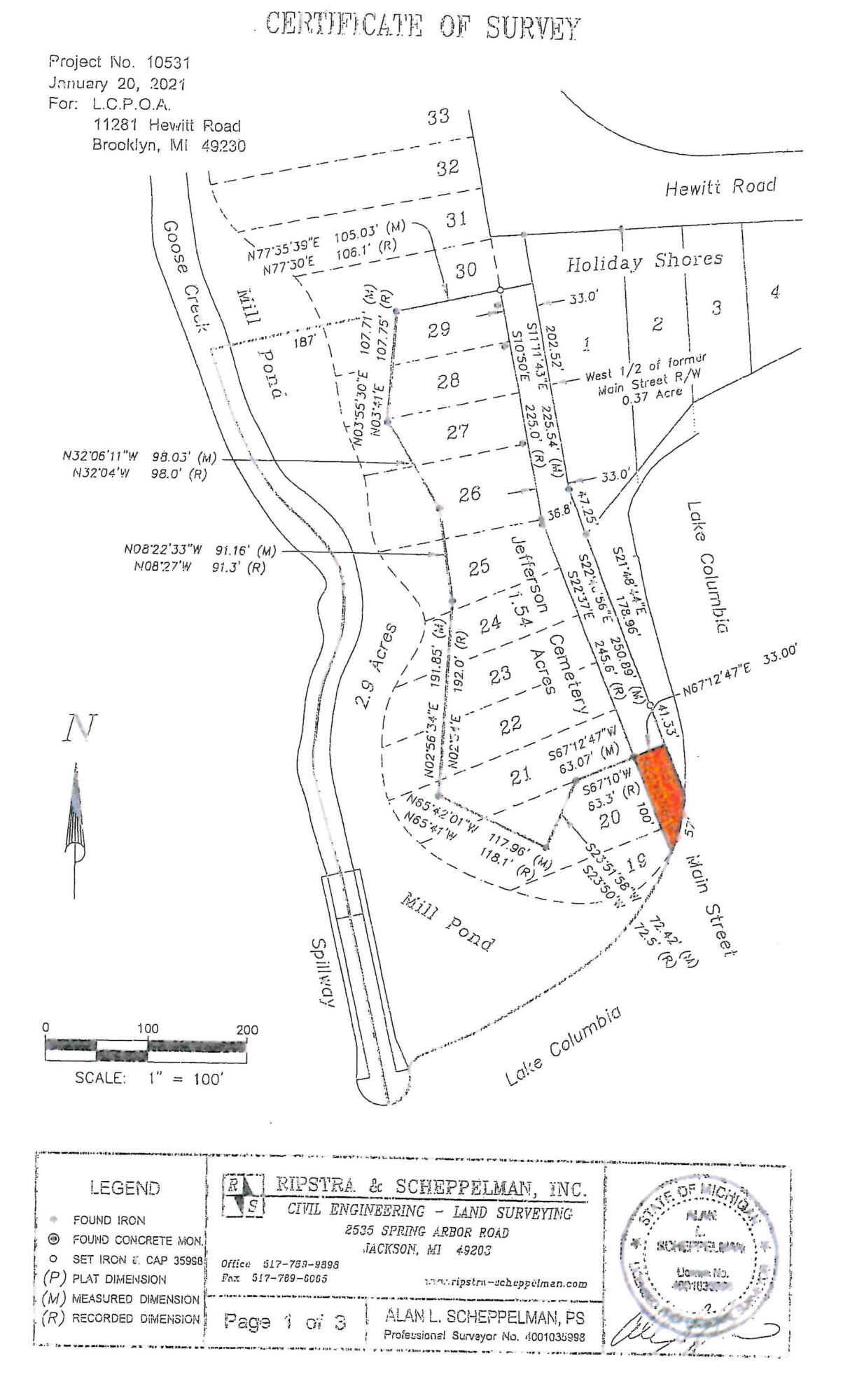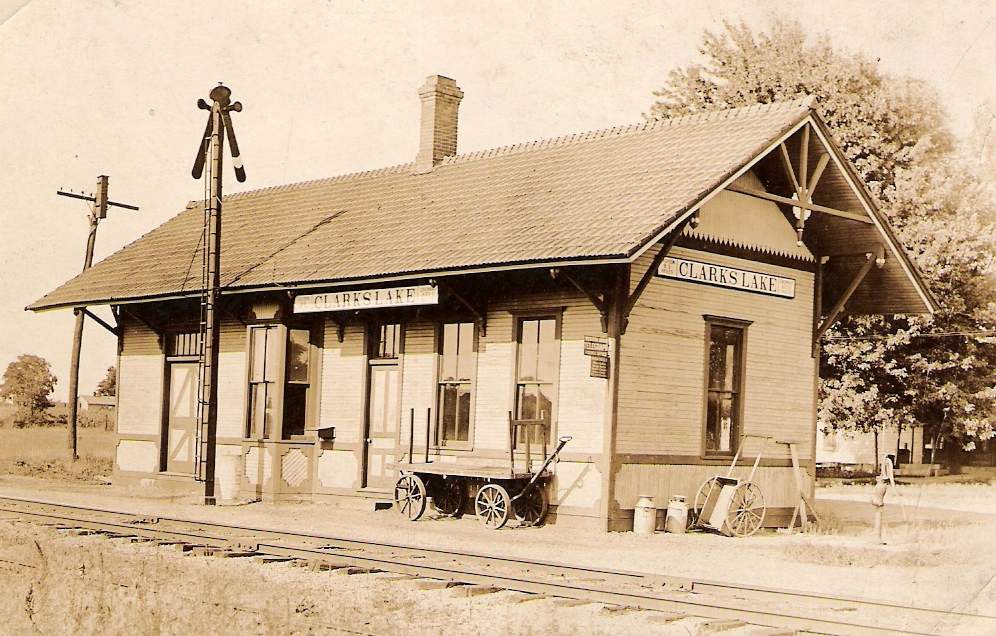
Recently whispers of the long forgotten past became slightly audible. Part of Main Street, Village of Jefferson, is now in the hands of the Lake Columbia Property Owners Association. Village of Jefferson? Yes, you read that correctly. The plat is nothing more than an open field, but now completes a piece of Lake Columbia land leading to the dam. See the orange shaded area in the map above. Below, for the sake of preserving history is another document that refers to the property.

How does Main Street, Village of Jefferson, figure into this transfer? Jefferson was once a growing town, but is now what you would call a ghost town. Bill Leutz researched its history, and what he found was published on this website in 2016. Starting with the next paragraph is another look at Bill’s fascinating story. In it you’ll learn why some towns grow, and others fade away. And when you finish reading about Jefferson, you’ll want to check out another ghost town in our midst–Fentonville.
Most current residents of Brooklyn and Clark Lake probably know very little about a town that once existed between them; the town of Jefferson. I have talked to younger acquaintances who have grown up on Clark Lake who have never heard of it. This is not surprising as it essentially vanished sometime between 1870 and 1900. But at one time it was very prosperous, in some ways even more so than Brooklyn. I recall hearing of it occasionally, but it was long gone before my time. Like Fentonville, it is a definite candidate for Ghost Towns of the area.
The history book opens on Jefferson in 1835. At that time, two brothers named John H. and Broadhead DuBois, purchased 320 acres in section 22, T4S, R1E (Township 4 South of the Meridian and Range 1 East of the Meridian.) At that time, this was still in Napoleon Township. Columbia Township wasn’t to be created by separating it from Napoleon for three more years. The DuBois brothers chose this land because they saw the potential to utilize the water power on what was then known as ‘the West Branch of the Raisin River.” We now call it Goose Creek. The dam they built to harness this water power was situated about halfway between the present Jefferson Road bridge and the existing Lake Columbia dam. They started both a gristmill and a sawmill that year. The sawmill was completed in 1836 and the gristmill the next year. Samuel Quigley served as initial millwright for both mills. The construction proceeded slowly as all materials had to come by wagons over primitive roads connecting the area to Detroit. Much of this would have been via the old “Sauk Trail” which had been improved a few years earlier under orders from President Monroe. By that time the DuBois brothers had other partners, including Anson DeLameter and his nephew D. C. DeLameter.
 This could be the only remaining structure connected to the Village of Jefferson. It might have been a town meeting hall and/or grange.
This could be the only remaining structure connected to the Village of Jefferson. It might have been a town meeting hall and/or grange.
Blacksmith shops were soon started, by William Silkworth and Mr. Reynolds and two general stores were added; one a partnership of Messrs. King and Fuller, and the other by John DuBois. Amos and L.F. Pickett came to town and opened a machine shop, also using waterpower from the little dam. David Peterson planted flax and constructed a wool carding mill, and was soon spinning thread from the flax and spinning wool into rolls for homespun yarn. In 1855, Charles Cary, who had arrived in Jefferson in 1835, purchased waterpower from the dam and began spinning and making woolen cloth. However, it turned out that there was insufficient additional power, and he had to close his factory and the machinery was moved to Ann Arbor. William Randall and his wife, Freelove, brought apple and pear seeds from their home in New York State, thus contributing to the origin of the area orchards.
Anson, as County Surveyor would plat the growing town in 1836, and D.C. DeLameter would become its first postmaster a year later. Sometimes it is a little confusing to follow this early history, as everything outside of Brooklyn was initially referred to as “the town of Columbia” after the township. Even that early post office was named Columbia. The town of Columbia was organized in the winter of 1838-39, and the first town meeting was held in Fuller’s Store on April 16, 1839. A full slate of twenty-two officers were elected, including Anson DeLameter as Supervisor, David Peterson as Town Clerk, and Broadhead DuBois as Treasurer.
 Clarks Lake train depot at the west end
Clarks Lake train depot at the west end
By the end of the Civil War, the little town of Jefferson had a wool mill, a saw mill, a sorghum mill, two blacksmith shops, a cooper’s shop, a machine shop, a flour mill, a Free Methodist church, and two general stores and was at least as prosperous as Brooklyn. Sheep raisers often brought their wool from as far away as Cambridge Junction in Lenawee County to be spun in Peterson’s mill.
So what happened?

Bill Leutz
It was a story being repeated in many similar towns across the country at that time. In 1870, Brooklyn won the battle for the Detroit, Indiana and Hillsdale Railroad. Jefferson slowly began to fall apart as newcomers went where the work was, and residents moved out. When the Cincinnati Northern Railroad laid track at the west end of the Clark’s Lake rather than the east end, Jefferson was finished. By 1908, H.A. Every bought the gristmill for salvage, using the lumber for construction projects at his newly purchased Eagle Point Hotel. Today, only the structure that was once the Church still stands near the junction of Wesch and Jefferson Roads. The Jefferson Cemetery still remains at the end of Hewitt Road, near the current dam for Lake Columbia. Other than this, all that really remains of Jefferson is a few lines in the history books.
Note: Columbia Township vacated the Jefferson plat to the LCPOA at their meeting Monday, January 16, 2023. Thanks to Kevin Thomson for help in developing the recent part of the story. As an attorney, he performed the legal work on behalf of Lake Columbia.











I remember my parents voting at the small bldg. that I think is still there , I think it may have been the township hall at one point, this was in the 1950’s. Also, at the end of Ocean Beach Rd. on south side of Jefferson there was a house, for years I remember it was abandoned, Mom said in the 40’s the sold chicken dinners from that location, and she and my grandmother went often to purchase a delicious meal ! Those of us that were born and raised at Clarklake , have a lot of info, as we lived year round, and not just summers at Eagle Point!
I also remember my parents, Hayes & Virginia Ganiard, voting at the old “Jefferson Township Hall building”, as we called it, when I was growing up in the 1950’s. It’s very difficult nowadays to remember exactly where the structure was located on that north side of Jefferson Rd., east of Wesch Rd., but I do remember after the framework of the structure disappeared, you could still see some remnants of the foundation as you drove past on Jefferson Rd.. I no longer can see them, so perhaps the foundation was removed.
To this day, nearly every time I drive to and from Brooklyn, I still think of the old “Jefferson Town Hall” building.
Ironically, I started teaching in Toledo, Ohio in 1961. My first supervisor was from Jefferson, Columbia Township, Michigan. She was very proud of this area and was excited that I summered at Clark Lake, Michigan.
I suspect the brick house on Jefferson Rd. at the top of the creek bank on its east crest was part of the village. It’s a substantial structure in a vernacular Greek Revival form and may date to the 1840s. And likely is one of the earliest remaining homes in the Township. Does anyone know more about this historic home?
My mom Janet Rhodes Trapp always said she was born in the dip in the road since she said she was always born in Jefferson in 1931.
Interesting that there was always a discussion whether it was Clarks Lake or Clark Lake. As noted on the train station at the west end of the Lake. Be interesting if someone could verify the name.